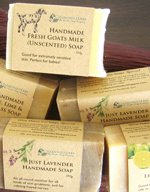 Whether it's English, Roman or German, this little herb is known for its wonderful calming qualities. I thought it would be interesting to highlight a few tidbits about the herb we've named our company after.
Whether it's English, Roman or German, this little herb is known for its wonderful calming qualities. I thought it would be interesting to highlight a few tidbits about the herb we've named our company after.This herb derives its name from the Greek "kamai melon", which means "ground apples". It has a distinct, pleasant herbaceous apple-like scent. It makes a great tea, slightly sweet and lacking the bitter overtones that tend to accompany most herbal teas. I personally love Tazo's Calm tea. It's great for aiding the digestion as well as unwinding and relaxing... important for someone who can't seem to welcome sleep like I do... and for some reason, it also calms my allergies. When I start sneezing and wheezing and my head gets stuffy, it's time for some Tazo.
The tea is relatively inexpensive and easy to obtain, which is a stark contrast to the essential oil. Chamomile essential oil is about double the price of most other essential oils. It's soothing, calming, anti-inflammatory, beneficial for dry, flaky, itchy, irritated skin and one of the few essential oils generally considered mild enough for use in baby products along with lavender and neroli. Because of the price though, chamomile essential oil is usually blended or used sparingly.
The hydrosol is the water from steam utilized during the distillation of essential oils. Miniscule droplets of essential oil remain in the water after the distillation process, giving hydrosols the water-soluble properties of the herb as well as a little of the oil-soluble properties. It's wonderful as a calming spritz for cranky, anxious people, as a mildly astringent and soothing toner for sensitive skin, though as it's mildly astringent, it probably should not be used over a long period of time by those with dry skin. Do note that hydrosols are completely different from some "floral waters" which are really just water with essential oils.
On to the interesting stuff... in folklore, chamomiles are used in prosperity charms to bring money (YAY!) and attract luck during gambling. It is the patron herb for gardens and is one of the nine sacred herbs of the "Lacnunga", which is an ancient Anglo-Saxon manuscript. It is dedicated to St. Anne, mother of the Virgin Mary, and is strongly associated with the Sun. It is a herb of healing, and represents "patience in adversity" due to its hardy nature. Sprinkling chamomile around one's property is believed to remove curses and bad spells. Added to the bath, it attracts love (man-hunting women, take note!).
In the world of culinary interests, chamomile isn't used much, but the foliage of the English chamomile can be chopped and stirred into butter or sour cream for the topping of baked potatoes and there is a Spanish wine that's flavored with chamomile, known as "manzanilla" or "little apple".
That's enough for one read, I should think... more soon!





No comments:
Post a Comment